Myski 26 February 2016
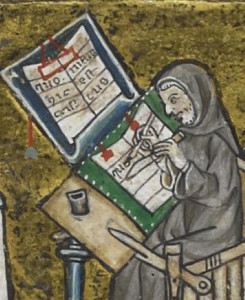 A Quick Course in Writing VMS-Style
A Quick Course in Writing VMS-Style
Nacimiento Have you ever had the urge to write something in Voynichese that looks reasonably authentic, not just the letters, but the word-structure as well?
You can download the EVA font here (near the bottom of the page) so that you can reproduce the letter-shapes, but if you string them together any-which-way, it won’t come out looking like Voynichese. Keep in mind also that there may be two “dialects” in the Voynich manuscript, two styles of letter-combinations called Currier-A and Currier-B and I’m only going to cover one of them in this blog.
If you would like to read more about the two VMS dialects, you can look here. I haven’t had a chance to read it yet (there’s a lot of good information on the site and not enough hours in the day) but I’m sure it’s informative and I WILL get to it soon (I hope). What follows is based on my own observations.
Character Order
I randomly chose a section of text in the biological section (f77r), and created a simplified version of rules you can follow that will result in a pretty good representation of Voynich glyph-order. It might even give you some sense of how the text is constructed. Note that this applies to the big blocks of text, not the labels.
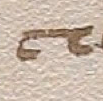
 Let’s start with one of the most common characters, the bench glyph. The bench char has some special properties that allow it to be split apart or to cross over other characters, but I’ll be describing a light version of Voynichese that works well for most of the text, so your brain doesn’t explode from trying to incorporate all the VMS idiosyncracies on the first go.
Let’s start with one of the most common characters, the bench glyph. The bench char has some special properties that allow it to be split apart or to cross over other characters, but I’ll be describing a light version of Voynichese that works well for most of the text, so your brain doesn’t explode from trying to incorporate all the VMS idiosyncracies on the first go.
If you’re not familiar with the EVA font-set, you can consult a chart here on René Zandbergen’s site. Scroll about halfway down to see the Basic Eva Characters.
In this version of VMS-Write-Lite, based on a limited text selection, the capped bench char and the bench char both behave the same way, but the capped bench char is used slightly more often.
The Rules of Engagement
 The bench chars can only appear at the beginnings of words unless preceded by the Gallows P or by EVA-l (ell). There is one exception, but the ink is blobbed and I suspect it was intended to be “cc” rather than a bench char. The bench chars are almost always followed by EVA-e but are occasionally followed by “a” “o” EVA-d” or a bench char that straddles a gallows character.
The bench chars can only appear at the beginnings of words unless preceded by the Gallows P or by EVA-l (ell). There is one exception, but the ink is blobbed and I suspect it was intended to be “cc” rather than a bench char. The bench chars are almost always followed by EVA-e but are occasionally followed by “a” “o” EVA-d” or a bench char that straddles a gallows character. The Eva-l (ell) must be preceded by an “o” or occasionally an “a” unless it’s the first letter in a word. It usually occurs with “o” or “a” about one to four times per line. I found only two exceptions to this on a full page of text. Near the bottom, there is one preceded by a bench char and one preceded by EVA-r.
The Eva-l (ell) must be preceded by an “o” or occasionally an “a” unless it’s the first letter in a word. It usually occurs with “o” or “a” about one to four times per line. I found only two exceptions to this on a full page of text. Near the bottom, there is one preceded by a bench char and one preceded by EVA-r. The EVA-d char (that looks like a figure-8) is always followed by EVA-y and placed at the end of words or by itself UNLESS it spells out “dar” or “d ar” or “dain”. I saw only one exception to this where the text butted against a drawing and there was no room to add EVA-y. The combination EVA-dy is always preceded by EVA-e (it looks like a “c”) unless the EVA-dy stands alone. I found only one exception to this and I strongly suspect the missing EVA-e is a transcription error.
The EVA-d char (that looks like a figure-8) is always followed by EVA-y and placed at the end of words or by itself UNLESS it spells out “dar” or “d ar” or “dain”. I saw only one exception to this where the text butted against a drawing and there was no room to add EVA-y. The combination EVA-dy is always preceded by EVA-e (it looks like a “c”) unless the EVA-dy stands alone. I found only one exception to this and I strongly suspect the missing EVA-e is a transcription error. The EVA-r is not quite as common and only occurs at the end of words preceded by “a” “i” or “o” or, occasionally, by itself. It occurs on average about once every couple of lines. Sometimes it is doubled up, but each instance still needs a vowel-shape in front of it and they can be different ones as in the example on the right. There is a peculiar exception that shows up further down the page. If EVA-r occurs at the end of a line, sometimes EVA-y or EVA-ol is added and I suspect this may be to pad out the line length, but I can’t be sure without more study.
The EVA-r is not quite as common and only occurs at the end of words preceded by “a” “i” or “o” or, occasionally, by itself. It occurs on average about once every couple of lines. Sometimes it is doubled up, but each instance still needs a vowel-shape in front of it and they can be different ones as in the example on the right. There is a peculiar exception that shows up further down the page. If EVA-r occurs at the end of a line, sometimes EVA-y or EVA-ol is added and I suspect this may be to pad out the line length, but I can’t be sure without more study. EVA-s can easily be mistaken for EVA-r so look carefully to make sure you don’t confuse them. After a while you get a feel for which one it is. The EVA-s occurs at the beginnings and ends of words and sometimes by itself (it’s by itself more often than most VMS characters). Whether it’s at the beginning of a word or by itself, it is almost always followed by EVA-a or occasionally EVA-o. In fact, if you aren’t completely sure if a shape is EVA-s or EVA-r, knowing this can help you figure it out.
EVA-s can easily be mistaken for EVA-r so look carefully to make sure you don’t confuse them. After a while you get a feel for which one it is. The EVA-s occurs at the beginnings and ends of words and sometimes by itself (it’s by itself more often than most VMS characters). Whether it’s at the beginning of a word or by itself, it is almost always followed by EVA-a or occasionally EVA-o. In fact, if you aren’t completely sure if a shape is EVA-s or EVA-r, knowing this can help you figure it out. EVA-q (which looks like the number 4) is almost invariably at the beginning of words (there are a few rare exceptions), and is almost always followed by “o”. In fact, the “o” is usually connected to the 4 which is notable if you consider that most letters are unconnected or only loosely and inconsistently connected. The 4o is almost always followed by a gallows character and in the uncommon instances where it’s not, it’s usually followed by EVA-d or EVA-l. There are a couple of exceptions in the last paragraph, where it is followed by “cc” and EVA-y but I will say more about these later, because I discovered something about the last paragraph on the page in another section as well.
EVA-q (which looks like the number 4) is almost invariably at the beginning of words (there are a few rare exceptions), and is almost always followed by “o”. In fact, the “o” is usually connected to the 4 which is notable if you consider that most letters are unconnected or only loosely and inconsistently connected. The 4o is almost always followed by a gallows character and in the uncommon instances where it’s not, it’s usually followed by EVA-d or EVA-l. There are a couple of exceptions in the last paragraph, where it is followed by “cc” and EVA-y but I will say more about these later, because I discovered something about the last paragraph on the page in another section as well.- EVA-i is a rare character and almost always follows “a”. There are a few exceptions but you have to hunt for them.
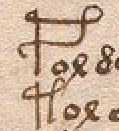 Gallows-P, Gallows-k and Gallows-t are almost never at the beginnings or ends of words unless it is the beginning of a paragraph or a line and then they are sometimes at the beginning. There are a few rare instances of Gallows-k at the beginnings of words mid-line (remember this is VMS-Write-Lite which documents only the more common patterns of one dialect as they appear in large blocks of text).
Gallows-P, Gallows-k and Gallows-t are almost never at the beginnings or ends of words unless it is the beginning of a paragraph or a line and then they are sometimes at the beginning. There are a few rare instances of Gallows-k at the beginnings of words mid-line (remember this is VMS-Write-Lite which documents only the more common patterns of one dialect as they appear in large blocks of text).- Gallows-k and -t are almost always followed by EVA-e (or EVA-e doubled) or by “ain” but are sometimes followed by EVA-al, -ar, or -y. Oddly, when they are followed by -y, it’s usually near the end of a line.
- Gallows-P is usually followed by EVA-ol (at the beginnings of lines) or the bench char.
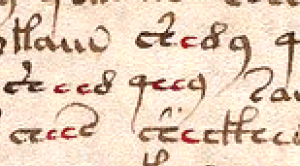 EVA-e is always midword and is often doubled (“cc”). I found only one exception in the last paragraph on f77r, and it’s a section that has been written over in darker pen (possibly by a different hand) where an “a” or bench char may have been misinterpreted as “cc”.
EVA-e is always midword and is often doubled (“cc”). I found only one exception in the last paragraph on f77r, and it’s a section that has been written over in darker pen (possibly by a different hand) where an “a” or bench char may have been misinterpreted as “cc”.- Gallows characters straddled by the bench char are usually midword, but are sometimes at the beginning. They’re not very common, occurring only four times on f77r. They are usually followed by EVA-e.
So that’s the basic structure in a nutshell for the most common characters.
Summary
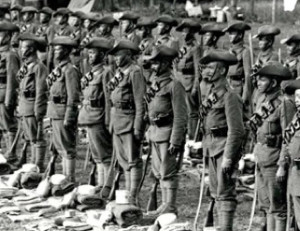 You may have noticed that VMS glyph position is quite rigid. The order and position of glyphs rarely varies from a strict set of rules, rules that are not characteristic of natural languages, rules that apply not only to letter-glyphs and glyph combinations but to their position in lines, as well.
You may have noticed that VMS glyph position is quite rigid. The order and position of glyphs rarely varies from a strict set of rules, rules that are not characteristic of natural languages, rules that apply not only to letter-glyphs and glyph combinations but to their position in lines, as well.
This is one of the reasons why one-to-one substitution codes are unlikely to get good results. It also brings up the question of whether glyph combinations represent one letter rather than two, but if the manuscript is interpreted this way, then the content would be very sparse and the word-lengths so short that spaces would have to be considered either contrived or arbitrary or, if they are abbreviations, a key to the abbreviations would have to be in the head of the writer or in another document.
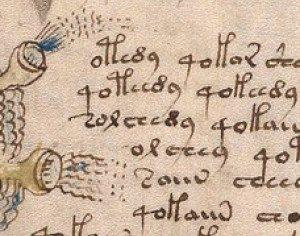 In English, we have a few conventions that one can relate to the VMS… for example, the word “the” typically precedes a noun, and the letter “q” is almost always followed by a “u”, and there are some common letter combinations like “sh” and “th” that might correspond to double letters in a ciphered script, but English is a mongrel language with many loan words from French, Norse, and other languages, and thus has considerable variation in how letters can be combined and where they may be positioned in a word.
In English, we have a few conventions that one can relate to the VMS… for example, the word “the” typically precedes a noun, and the letter “q” is almost always followed by a “u”, and there are some common letter combinations like “sh” and “th” that might correspond to double letters in a ciphered script, but English is a mongrel language with many loan words from French, Norse, and other languages, and thus has considerable variation in how letters can be combined and where they may be positioned in a word.
It’s probably more fruitful to look at ancient languages and some of the Asian languages to find text with a structure similar to the VMS. In terms of letter order and positioning, the syllabic languages (where a predetermined set of syllables is combined in specific ways) and abjads (languages that are typically written without vowels) have more in common with the VMS than English, German, French, Latin, Spanish or other European languages. It’s also possible that the VMS text has mathematical underpinnings rather than a direct relationship to a natural language.
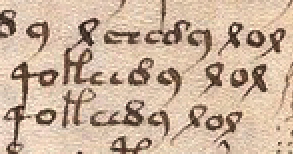 This rigidity, and a character set that is constrained by positional rules, may also account for the extreme level of repetition that is found in the VMS. Significant repetition is not uncommon in medieval documents, it happens frequently in recipes, calenders, charms, and chants, but it’s also possible that the repetition in the VMS results partly from the textual structure.
This rigidity, and a character set that is constrained by positional rules, may also account for the extreme level of repetition that is found in the VMS. Significant repetition is not uncommon in medieval documents, it happens frequently in recipes, calenders, charms, and chants, but it’s also possible that the repetition in the VMS results partly from the textual structure.
If you like to code, you might enjoy generating some text algorithmically based on this rule-set combined with some study of the referenced folio. Even if you don’t like to code, studying the glyph-grammar of the VMS text might yield some insights on how it was constructed.
J.K. Petersen
© Copyright 2015 J.K. Petersen, All Rights Reserved
